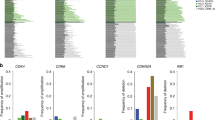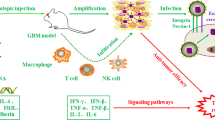Abstract
The fact that glioblastomas, which are one of the most devastating cancers, frequently express the Delta-EGFR (epithelial growth factor receptor) also called mutant variant III of EGFR (EGFRvIII) suggests that this cancer cell-specific receptor might serve as an ideal target for cancer therapy. To assess its potential as such a target, we constructed an oncolytic adenovirus with Retargeted Infectivity Via EGFR (Delta-24-RIVER) on the backbone of Delta-24. This new oncolytic adenovirus targets, as Delta-24 does, the disrupted Rb pathway in cancer cells; in addition, this adenovirus has also been retargeted through the abrogation of CAR binding (Y477A mutation in adenoviral fiber protein) and insertion of an EGFRvIII-specific binding peptide in the HI loop of the fiber protein. As compared with Delta-24, Delta-24-RIVER induced EGFRvIII-selective cytotoxicity in U-87 MG isogenic cell lines and in tetracycline-inducible EGFRVIII expressing U-251 MG cells. Accordingly, by tittering the viral progeny and examining fiber protein expression in the above cells, we showed that the replication of this new construct also correlated with EGFRvIII expression. Consistently, immunohistochemistry staining of the adenoviral capsid protein hexon in the virus-treated tumors revealed that the virus replicated more efficiently in EGFRvIII-expressing U-87 MG.ΔEGFR xenografts than in the tumors grown from U-87 MG cells. Importantly, treatment with Delta-24-RIVER prolonged the survival of animals with intracranial xenografts derived from U-87 MG.ΔEGFR cells. Therefore, our results constitute the first proof of the direct targeting of a cancer-specific receptor using an oncolytic adenovirus.
This is a preview of subscription content, access via your institution
Access options
Subscribe to this journal
Receive 12 print issues and online access
$259.00 per year
only $21.58 per issue
Buy this article
- Purchase on Springer Link
- Instant access to full article PDF
Prices may be subject to local taxes which are calculated during checkout




Similar content being viewed by others
References
Ohgaki H, Kleihues P . Genetic pathways to primary and secondary glioblastoma. Am J Pathol 2007; 170: 1445–1453.
Stupp R, Mason WP, van den Bent MJ, Weller M, Fisher B, Taphoorn MJ et al. Radiotherapy plus concomitant and adjuvant temozolomide for glioblastoma. N Engl J Med 2005; 352: 987–996.
Furnari FB, Fenton T, Bachoo RM, Mukasa A, Stommel JM, Stegh A et al. Malignant astrocytic glioma: genetics, biology, and paths to treatment. Genes Dev 2007; 21: 2683–2710.
Jiang H, McCormick F, Lang FF, Gomez-Manzano C, Fueyo J . Oncolytic adenoviruses as antiglioma agents. Expert Rev Anticancer Ther 2006; 6: 697–708.
Kuan CT, Wikstrand CJ, Bigner DD . EGFRvIII as a promising target for antibody-based brain tumor therapy. Brain Tumor Pathol 2000; 17: 71–78.
Fueyo J, Gomez-Manzano C, Alemany R, Lee PS, McDonnell TJ, Mitlianga P et al. A mutant oncolytic adenovirus targeting the Rb pathway produces anti-glioma effect in vivo. Oncogene 2000; 19: 2–12.
Fueyo J, Alemany R, Gomez-Manzano C, Fuller GN, Khan A, Conrad CA et al. Preclinical characterization of the antiglioma activity of a tropism-enhanced adenovirus targeted to the retinoblastoma pathway. J Natl Cancer Inst 2003; 95: 652–660.
Barnett BG, Crews CJ, Douglas JT . Targeted adenoviral vectors. Biochim Biophys Acta 2002; 1575: 1–14.
Mishima K, Johns TG, Luwor RB, Scott AM, Stockert E, Jungbluth AA et al. Growth suppression of intracranial xenografted glioblastomas overexpressing mutant epidermal growth factor receptors by systemic administration of monoclonal antibody (mAb) 806, a novel monoclonal antibody directed to the receptor. Cancer Res 2001; 61: 5349–5354.
Ramnarain DB, Park S, Lee DY, Hatanpaa KJ, Scoggin SO, Otu H et al. Differential gene expression analysis reveals generation of an autocrine loop by a mutant epidermal growth factor receptor in glioma cells. Cancer Res 2006; 66: 867–874.
Belousova N, Korokhov N, Krendelshchikova V, Simonenko V, Mikheeva G, Triozzi PL et al. Genetically targeted adenovirus vector directed to CD40-expressing cells. J Virol 2003; 77: 11367–11377.
Alemany R, Curiel DT . CAR-binding ablation does not change biodistribution and toxicity of adenoviral vectors. Gene Therapy 2001; 8: 1347–1353.
Campa MJ, Kuan CT, O’Connor-McCourt MD, Bigner DD, Patz Jr EF . Design of a novel small peptide targeted against a tumor-specific receptor. Biochem Biophys Res Commun 2000; 275: 631–636.
Belousova N, Krendelchtchikova V, Curiel DT, Krasnykh V . Modulation of adenovirus vector tropism via incorporation of polypeptide ligands into the fiber protein. J Virol 2002; 76: 8621–8631.
Mahasreshti PJ, Kataram M, Wu H, Yalavarthy LP, Carey D, Fisher PB et al. Ovarian cancer targeted adenoviral-mediated mda-7/IL-24 gene therapy. Gynecol Oncol 2006; 100: 521–532.
Jiang H, Alemany R, Gomez-Manzano C, Medrano DR, Lemoine MG, Olson MV et al. Downmodulation of E1A protein expression as a novel strategy to design cancer-selective adenoviruses. Neoplasia 2005; 7: 723–729.
Jiang H, Gomez-Manzano C, Aoki H, Alonso MM, Kondo S, McCormick F et al. Examination of the therapeutic potential of Delta-24-RGD in brain tumor stem cells: role of autophagic cell death. J Natl Cancer Inst 2007; 99: 1410–1414.
Ariani F, Mari F, Pescucci C, Longo I, Bruttini M, Meloni I et al. Real-time quantitative PCR as a routine method for screening large rearrangements in Rett syndrome: report of one case of MECP2 deletion and one case of MECP2 duplication. Hum Mutat 2004; 24: 172–177.
Bergelson JM, Cunningham JA, Droguett G, Kurt-Jones EA, Krithivas A, Hong JS et al. Isolation of a common receptor for Coxsackie B viruses and adenoviruses 2 and 5. Science 1997; 275: 1320–1323.
Bernt KM, Ni S, Gaggar A, Li ZY, Shayakhmetov DM, Lieber A . The effect of sequestration by nontarget tissues on anti-tumor efficacy of systemically applied, conditionally replicating adenovirus vectors. Mol Ther 2003; 8: 746–755.
Rivera AA, Davydova J, Schierer S, Wang M, Krasnykh V, Yamamoto M et al. Combining high selectivity of replication with fiber chimerism for effective adenoviral oncolysis of CAR-negative melanoma cells. Gene Therapy 2004; 11: 1694–1702.
Shinoura N, Yoshida Y, Tsunoda R, Ohashi M, Zhang W, Asai A et al. Highly augmented cytopathic effect of a fiber-mutant E1B-defective adenovirus for gene therapy of gliomas. Cancer Res 1999; 59: 3411–3416.
Suzuki K, Fueyo J, Krasnykh V, Reynolds PN, Curiel DT, Alemany R . A conditionally replicative adenovirus with enhanced infectivity shows improved oncolytic potency. Clin Cancer Res 2001; 7: 120–126.
Trembath DG, Lal A, Kroll DJ, Oberlies NH, Riggins GJ . A novel small molecule that selectively inhibits glioblastoma cells expressing EGFRvIII. Mol Cancer 2007; 6: 30.
Lorimer IA . Mutant epidermal growth factor receptors as targets for cancer therapy. Curr Cancer Drug Targets 2002; 2: 91–102.
Lorimer IA, Lavictoire SJ . Targeting retrovirus to cancer cells expressing a mutant EGF receptor by insertion of a single chain antibody variable domain in the envelope glycoprotein receptor binding lobe. J Immunol Methods 2000; 237: 147–157.
Snitkovsky S, Niederman TM, Carter BS, Mulligan RC, Young JA . A TVA-single-chain antibody fusion protein mediates specific targeting of a subgroup A avian leukosis virus vector to cells expressing a tumor-specific form of epidermal growth factor receptor. J Virol 2000; 74: 9540–9545.
Allen C, Vongpunsawad S, Nakamura T, James CD, Schroeder M, Cattaneo R et al. Retargeted oncolytic measles strains entering via the EGFRvIII receptor maintain significant antitumor activity against gliomas with increased tumor specificity. Cancer Res 2006; 66: 11840–11850.
Grill J, Van Beusechem VW, Van Der Valk P, Dirven CM, Leonhart A, Pherai DS et al. Combined targeting of adenoviruses to integrins and epidermal growth factor receptors increases gene transfer into primary glioma cells and spheroids. Clin Cancer Res 2001; 7: 641–650.
Ayuso-Sacido A, Graham C, Greenfield JP, Boockvar JA . The duality of epidermal growth factor receptor (EGFR) signaling and neural stem cell phenotype: cell enhancer or cell transformer? Curr Stem Cell Res Ther 2006; 1: 387–394.
Lammering G, Valerie K, Lin PS, Hewit TH, Schmidt-Ullrich RK . Radiation-induced activation of a common variant of EGFR confers enhanced radioresistance. Radiother Oncol 2004; 72: 267–273.
Nagane M, Levitzki A, Gazit A, Cavenee WK, Huang HJ . Drug resistance of human glioblastoma cells conferred by a tumor-specific mutant epidermal growth factor receptor through modulation of Bcl-XL and caspase-3-like proteases. Proc Natl Acad Sci USA 1998; 95: 5724–5729.
Huang PH, Cavenee WK, Furnari FB, White FM . Uncovering therapeutic targets for glioblastoma: a systems biology approach. Cell Cycle 2007; 6: 2750–2754.
Mellinghoff IK, Wang MY, Vivanco I, Haas-Kogan DA, Zhu S, Dia EQ et al. Molecular determinants of the response of glioblastomas to EGFR kinase inhibitors. N Engl J Med 2005; 353: 2012–2024.
Fulci G, Breymann L, Gianni D, Kurozomi K, Rhee SS, Yu J et al. Cyclophosphamide enhances glioma virotherapy by inhibiting innate immune responses. Proc Natl Acad Sci USA 2006; 103: 12873–12878.
Acknowledgements
We thank Betty Notzon (Department of Scientific Publications, The University of Texas MD Anderson Cancer Center) for editorial support and Verlene Henry and Jennifer Edge (Brain Tumor Center, The University of Texas MD Anderson Cancer Center) for technical assistance in the in vivo experiments. These studies were supported by R01-CA090879 and R01 CA116621 from National Cancer Institute (to JF and VK, respectively), Marcus Foundation (to JF and CAC), Nick Eric Wichman Foundation grant (to JF and CG-M), an Institutional Research Grant to MD Anderson (to HJ), and NCI CA-16672 grant (to MD Anderson Cancer Center: DNA Analysis, Research Animal Support, and Media Preparation Facilities).
Author information
Authors and Affiliations
Corresponding author
Rights and permissions
About this article
Cite this article
Piao, Y., Jiang, H., Alemany, R. et al. Oncolytic adenovirus retargeted to Delta-EGFR induces selective antiglioma activity. Cancer Gene Ther 16, 256–265 (2009). https://doi.org/10.1038/cgt.2008.75
Received:
Revised:
Accepted:
Published:
Issue Date:
DOI: https://doi.org/10.1038/cgt.2008.75
Keywords
This article is cited by
-
Chronic sun exposure-related fusion oncogenes EGFR-PPARGC1A in cutaneous squamous cell carcinoma
Scientific Reports (2017)
-
Barriers to systemic application of virus-based vectors in gene therapy: lessons from adenovirus type 5
Virus Genes (2017)
-
Advances in immunotherapy for the treatment of glioblastoma
Journal of Neuro-Oncology (2017)
-
Oncolytic parvoviruses: from basic virology to clinical applications
Virology Journal (2015)
-
Sstr2A: a relevant target for the delivery of genes into human glioblastoma cells using fiber-modified adenoviral vectors
Gene Therapy (2013)



